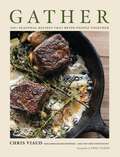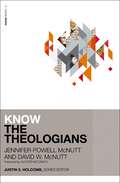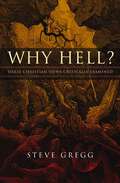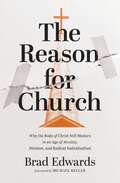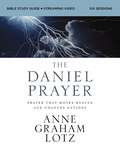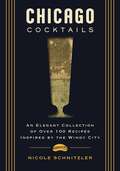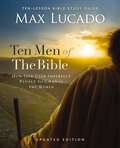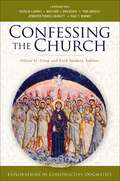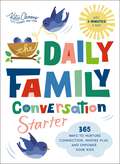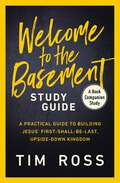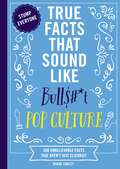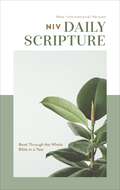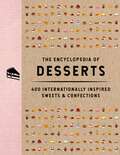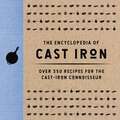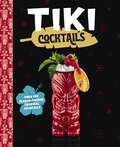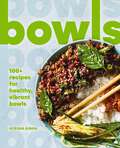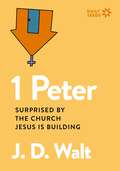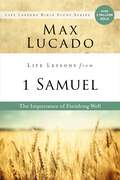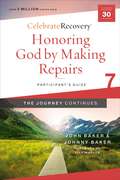- Table View
- List View
GATHER: 100 Seasonal Recipes that Bring People Together
by Chris ViaudFrom James Beard nominee and Top Chef contestant Chef Chris Viaud comes GATHER, featuring recipes that not only bring friends and family together but keep them at the table. Whether you&’re hosting a cookbook club night in, or offering a housewarming gift to new neighbors, this mouth-watering cookbook will satisfy all cravings.To Chef Chris Viaud, food is a shared language that allows us to communicate with complete strangers, create lasting memories with friends and family, and get in touch with ourselves. It is the best way to nourish and expand a community. GATHER is a celebration of food&’s magical capacity to connect and transform. Featuring 100 recipes that focus on the innovative, accessible, and seasonal cuisine that earned Viaud a James Beard nomination and wowed the judges on Top Chef, this cookbook is centered around the incredible potential in gatherings of all sizes.Inside you&’ll find:100 seasonal appetizersBold and wholesome family-style entreesUnique, eye-catching cocktails perfect for entertainingElegant desserts for all cravingsStunning original photographyTips and techniques that promise to revolutionize your approach in the kitchen GATHER is perfect gift for:Mother&’s day or Father&’s day for the chefs in your lifeHost or hostess who enjoy entertainingHousewarming or new homeownersChristmas, birthdays, or other holidaysEasy to assemble and satisfying to serve, this repertoire is made for the heart of your home. Foster a deeper appreciation for every aspect of a meal, from those who cultivated the ingredients to the ones who sit beside us at the table. Feel good about what you put on your plate with GATHER.
Know the Theologians (KNOW Series)
by Jennifer Powell McNutt David McNuttFinalist for the 2025 Christianity Today Book Award in Popular TheologyKnow the Theologians is an introduction to the most important thinkers throughout church history and a demonstration of their ongoing relevance for believers today.The Bible describes the church as a kind of family. Those who believe in Christ are sisters and brothers in the faith, whether they live at the same time or are separated by centuries. For that reason, believers today need to know our family members who have come before and shaped our beliefs and practices now. In Know the Theologians, professors and authors Jennifer Powell McNutt and David W. McNutt introduce the most significant thinkers in the church's history.McNutt and McNutt survey over a dozen primary figures, including Eastern Orthodox, Roman Catholic, and Protestant theologians, who represent the breadth and depth of the church's theology. The book explores how they fit into their own time period and also draws attention to the theological voices of women throughout the church's history. Every chapter includes short sidebars on figures contemporary to the main theologians, bringing in additional important voices.This book has everything you need for a full personal or group study experience.As part of the KNOW series, Know the Theologians is designed for either personal study or classroom use, and it will also be an accessible resource for small groups and adult education in churches. Chapters end with reflection questions and recommended reading for further study.An individual access code to stream all video sessions online. (You don&’t need to buy a DVD!)Sessions:PART 1: EARLY CHRISTIAN THEOLOGIANS1. Irenaeus of Lyons2. Athanasius of Alexandria3. The Cappadocian Four4. Augustine of HippoPART 2: MEDIEVAL THEOLOGIANS5. John of Damascus6. Anselm of Canterbury7. Julian of Norwich8. Thomas AquinasPART 3: REFORMATION THEOLOGIANS9. Martin Luther10. John Calvin11. Menno Simons12. Teresa of AvilaPART 4: MODERN THEOLOGIANS13. The Wesley Brothers14. Friedrich Schleiermacher15. Karl Barth16. Gustavo GutiérrezStreaming video access code included.?Access code subject to expiration after 4/2/2029. Code may be redeemed only by the recipient of this package. Code may not be transferred or sold separately from this package. Internet connection required. Void where prohibited, taxed, or restricted by law. Additional offer details inside.
Why Hell?: Three Christian Views Critically Examined
by Steve GreggMost people believe that hell is the final state of the condemned following the final judgment. At the same time, many people cannot comprehend why God created hell for the unsaved. Respected church fathers held a variety of views dating back to the early centuries of the church. This book explains views on why hell exists: unending suffering, the annihilation of the unrepentant, and the rehabilitation of the lost. Most Christians are unaware of the scriptural basis for each of these positions. Why Hell? is meant to educate the interested reader without advocating for any one point of view. The following are some of the book's features:Biblical vocabulary of hell and positions held throughout early Christian historyPositive cases presented on three perspectives: traditionalist, conditionalist, and restorationistCritiques of each viewHelpful charts at the back of the book that summarize and cross-examine the arguments for each viewSteve Gregg provides food for thought for both trained theologians and serious Christian readers who want all the data and then consider for themselves the consequences of three Christian perspectives on hell.
Let Them Eat Cupcakes: 100 Cupcake Recipes to Rule Them All
by Gabrielle CoteIn the spirit of the famously misattributed Marie Antoinette quote, "Let them eat cake," we invite you to a more contemporary, and certainly more fun, baking extravaganza--Let Them Eat Cupcakes!It&’s time to overthrow the tyranny of ordinary desserts and crown cupcakes as the rightful monarchs of your baking repertoire. This cookbook is a call-to-arms for all dessert enthusiasts, with 100 recipes that are as deliciously decadent as a queen&’s banquet. These recipes are carefully crafted to be easy-to-follow, so novice bakers and experts in the kitchen can create themed treats for every occasion.Inside you&’ll find themed recipes perfect for:Holidays, from New Year&’s Eve to Mother&’s Day and Fourth of JulyBridal showers, garden parties, and moreSeasonal treatsDelicious classicsDon your apron, grab your whisk, and join us in the kitchen revolution with Let Them Eat Cupcakes!
The Reason for Church: Why the Body of Christ Still Matters in an Age of Anxiety, Division, and Radical Individualism
by Brad EdwardsRediscover the goodness and beauty of the Body of Christ.The evangelical church is hemorrhaging. Over 40 million Americans have dechurched in the last 25 years alone, and multiple generations have been raised to believe the most spiritual thing they can do is follow God by following their heart--right out of the church. Yet, this shift is happening right as society is hitting record levels of loneliness, stress, and anxiety. In The Reason for Church, pastor Brad Edwards connects the dots of our current church crisis and provides compelling reasons to come back.In part 1, Edwards shows how individualistic beliefs make church implausible and compromise our spiritual formation:Marketplace logic and consumeristic approaches to discipleshipIntuitional spirituality and therapy speakSocial media's distortion of what is true, good, and beautifulPerformative politics and culture warsVirtuous victimhood, the decline of trust, and the rise of powerThese chapters show why individualism won't satisfy and can't provide the refuge it promises.In part 2, Edwards uses personal examples, church history, non-Western expressions of faith, and Scripture to show how the church is our existentially satisfying alternative to individualism. Equipped with an institutionally robust vision, we will rediscover the church as God's spiritual greenhouse where soul-tired sojourners and lonely exiles are restored and repurposed for life in the world.The Reason for Church offers an honest-yet-hopeful vision for church as a necessary institution. With radical individualism tearing us apart, we need compelling reasons to fall back in love with Christ's bride, now more than ever.
Forever Bible Study Guide: The Story of God Making All Things Right (Jesus Bible Study Series)
by Passion PublishingThe purpose of The Jesus Bible Study Series is to help readers understand that Jesus is front and center throughout the Bible. He is as visible on the first page of Genesis as he is on the last page in Revelation—as present in the Garden of Eden as he is in the garden tomb and the new heavens and new earth. As readers follow this thread, they will discover a new depth to the Bible's meaning as they come to discover Christ in every chapter of the story.In Forever, the sixth study in this series, readers will come to the conclusion and resolution of God's great story. At a time that only the Father knows, everything in heaven and earth will be put right once and for all. Those opposed to Jesus will get what they have asked for—an eternity without his goodness and glory. The redeemed will gather in his presence from every race and nation, singing the song of Jesus who rescued them from death and brought them into unending life.Lessons include:The Other SideFocused on EternityThe Narrow WayForever ChangedVision of HeavenBeginning and End
The Daniel Prayer Bible Study Guide plus Streaming Video, Updated Edition: Prayer That Moves Heaven and Changes Nations
by Anne Graham LotzDo you long for a more powerful prayer life? Do you grow discouraged when your prayers don't seem to change anything or allow you to hear God's voice?In this six-session video Bible study workshop (video access included), Anne Graham Lotz presents a biblical approach to prayer that will help you:Learn to listen for God's voice,Know Him in a personal relationship,and Communicate with Him through His Word.By taking a close look at the life of Daniel, Anne unpacks the prayer he prayed in Daniel 9. Following the pattern of Daniel's original prayer as a model for how we speak to our Creator, she helps us develop a more meaningful and powerful prayer life.For an entire generation, Daniel's people had been held in captivity and separated from their homeland. But when Daniel read a prophecy in which God said He would restore His people to Jerusalem after seventy years, he claimed that promise and cried out for to the Lord to bring it to pass. Daniel's example of praying God's Word back to Him is what Anne calls "reversed thunder."In this six-session study, Anne explains how we can reverse the thunder until Heaven is moved and we see real change in our own lives and the lives of those we're praying for.This study guide has everything you need for a full Bible study experience, including:The study guide itself—with video notes, personal study and group discussion sections, and a guide to best practices for leading a group.An individual access to stream all six video sessions online. (DVD also available separately) This guide includes weekly Bible study readings, group activities, and space for writing your own prayers. It is ideal for use in small groups and Sunday school classes and includes a simplified Bible study track for more limited meeting time (such as a workplace lunchtime setting). Sessions and run times include:Bible Study Workshop (48:00)Preparing for Prayer (17:00)Prompting in Prayer (22:30)Pleading in Prayer (25:00)Prevailing in Prayer (18:00)The Battle in Prayer (25:00)Streaming video access code included. Access code subject to expiration after 12/31/2029. Code may be redeemed only by the recipient of this package. Code may not be transferred or sold separately from this package. Internet connection required. Void where prohibited, taxed, or restricted by law. Additional offer details inside.
Chicago Cocktails: An Elegant Collection of Over 100 Recipes Inspired by the Windy City (City Cocktails)
by Nicole SchnitzlerAn elegant collection of over 100 recipes inspired by Chicago.From fruity juleps to creamy sours and old school martinis, these signature recipes from Chicago hotspots pay homage to the Windy City. With over 100 recipes and dozens of bartender profiles, you can drink like a local wherever you are. This book is broken down by neighborhood, so you can find the best bars and finest signature creations that Vancouver has to offer. Residents and tourists alike will discover locations and drinks that are sure to satisfy all tastes.Within the gorgeous, die-cut covers, you'll find:More than 100 essential and exciting cocktail recipes, including recipes for bespoke ingredients and other serving suggestionsInterviews with the city&’s trendsetting bartenders and mixologistsBartending tips and techniques from the expertsFood and drink destinations across the cityAnd much more!Get a taste of Chicago's craft cocktail scene without ever leaving your zip code with Chicago Cocktails.
Ten Men of the Bible Updated Edition: How God Used Imperfect People to Change the World
by Max LucadoWe Find Our Hope Where They Found Theirs. . .In this updated, ten-session workbook, Max Lucado uncovers lessons from the lives of ten of the most prominent men of the Bible.The men depicted in the Bible were not perfect by any means. We find story after story marked by scandal, failure, and intrigue. Yet we also find many stories of men who were able to look beyond their circumstances, completely trust in the Lord, and follow Him wherever He chose to take them.Like us, these men made both good and bad decisions along the way—and experienced both good and bad consequences—and we find our struggles and hopes in the pages of the Bible that tells their stories:Noah: When You're Low on HopeJob: The Most Famous Conversation in the BibleJacob: Wrestling with the PastMoses: The Voice from the Mop BucketDavid: Colossal CollapsesJoseph: Unanswered QuestionsMatthew: Friend of FlopsPeter: The Gospel of the Second ChanceLazarus: The Final WitnessPaul: Don&’t Write Off Anyone Each lesson includes insights on each character and Bible study questions to help you delve into the stories and apply them to your life.
Organic Prayer: Discover the Presence and Power of God in the Everyday (Organic Outreach)
by Kevin G. Harney Sherry HarneyOften we view prayer as an activity reserved for a certain time, in a certain place, offered in a specific way. Scripture invites us to pray continually. This exhortation is an opportunity for prayer to permeate every aspect of our lives--when we're alone or in a crowd, when it's quiet and when it's chaotic, when we feel like it and when we don't.?Organic Prayer shows us how to make continuous prayer a natural part of our lives rather than something on a spiritual checklist. It helps us encounter God in new ways as we learn to:?open our eyes to see his presence and the world around us?open our ears to hear his voice guiding us?open our hearts to experience freedom and power as we pray?and open our lives as we pray for and with others and shine the light of Jesus in our dark world?Anyone desiring a richer, more transformative prayer life will welcome this fresh take on conversing with our Creator.? Anyone hungering to share the grace and goodness of Jesus in our hurting and confused world will find practical ideas for world-changing prayer.
Confessing the Church: Explorations in Constructive Dogmatics (Los Angeles Theology Conference Series)
by ZondervanThe 2023 Los Angeles Theology Conference examines ecclesiology, that is, the doctrine about the Church. Conference contributions offer constructive proposals for understanding and confessing the doctrine of the Church with historical depth, ecumenical scope, and analytic clarity. This book contains the proceedings of the conference.
Playful by Design: Your Stress-Free Guide to Raising Confident, Creative Kids through Independent Play
by Myriam SandlerHelp your kids grow into confident, creative, and independent little people by creating spaces in your home that foster independent play.Myriam Sandler, creator and founder of Mothercould, helps you give your kids the tools they need to unlock their imaginations and encourage kid-directed, kid-executed, and ultimately kid-enriching independent play using the materials and spaces you already have. Not only will this system help your children grow, it will also help foster a more connected, more productive, and happier home for your entire family.Through colorful photography and vibrant illustration Playful by Design is your blueprint for effortlessly designing, installing, and maintaining your own upgraded play spaces. Myriam Sandler has created a resource to help you—easily and affordably—create spaces for independent play, no matter how big or small your home is.Myriam shares activities that:Build problem-solving skillsEncourage social and academic developmentEngage children while building moments of play and connectionNurture independence and self-expressionHelp work through emotions, andOffer parents important parenting wins that benefit the entire family As your kids engage with self-directed, open-ended play, you'll realize what a game-changer this new dynamic is for the entire household. For the parents, there's no more feeling overwhelmed and stretched thin by unrealistic expectations about how to entertain your kids. And for your kids, you're giving them the most beautiful gift: the ability to be independent self-starters who are in touch with their own creativity. In short: everyone will feel happier, more energized, more fulfilled, and more connected.Myriam will help you:Plan the spaceDeclutterOrganize by type (and customize for various age groups!)Set up a toy rotation systemMaintain (easily and efficiently!) In addition to the how, Myriam explains the why. This beautifully designed book will equip you to understand the importance of independent play, as well as set it into motion. You'll discover that boredom can be a good thing, and you'll see how it can make their imaginations blossom. This type of play creates more time for your kids to grow as creative and independent little people; more time for you to do the things you need and want to do; more peace of mind that you are, in fact, giving your kids important tools they'll thank you for one day; and more opportunities to feel the joy of all of the above.
The Daily Family Conversation Starter: 366 Ways to Nurture Connection, Inspire Play, and Empower Your Kids (Ideas for Questions and Activities that Build Better Relationships and Create Memories)
by Katie ClemonsDiscover how to strengthen your family bond and create memories that last a lifetime.Your stronger family connection starts here with just 5 minutes of conversation each day. The Daily Family Conversation Starter contains 365 easy and imaginative ways to check in with your kids, develop deeper relationships, and get both serious and silly—together! Every interactive activity and open-ended conversation prompt will help you build the family bond you've always dreamed of.Prompts like these will get your family talking—and you may find it hard to get them to stop!Who made you laugh today?What would you do if you had a tail?Why do you think it's important to try new things, even if it means you get knocked down?In addition to engaging conversation starters, you'll find inside:Easy activities for working togetherFill-in-the-blank questions that everyone can answerSpontaneous games that infuse whimsy into your family's daily routineMini essays to help your family discuss difficult topics or new concepts Whether commuting together, sitting at the dinner table, or preparing for bedtime, The Daily Family Conversation Starter invites you to share, discover, and laugh together as you create family memories that last a lifetime.
San Francisco Cocktails: An Elegant Collection of Over 100 Recipes Inspired by the City by the Bay (San Francisco History, Cocktail History, San Fran Restaurants and Bars, Mixology, Profiles, Books for Travelers and Foodies) (City Cocktails)
by Trevor FelchMix up a taste of the City by the Bay and experience San Francisco without ever leaving home!Eating and drinking are always the topics of the day in this city that is unlike any other. With San Francisco Cocktails, you will be transported to the biggest small-town city in America.Inside, you will find: Easy-to-follow recipes sure to be crowd pleasersCocktail basics for your home bar, including glassware, tools, and spiritsChapters dedicated to your favorite San Francisco neighborhoodsProfiles on some of the most recognizable bars in San Francisco along with the cocktail recipes that make them stand outInterviews with local bartendersGorgeous, full-color photography gives you a taste of each cocktail long before you mix them up yourselfA list of songs and movies that will help you truly grasp the San Francisco experienceNo matter where you find yourself, San Francisco Cocktails is the perfect gift for cocktail lovers everywhere. This is the perfect guide for drinking like a true San Franciscan.
Welcome to the Basement Study Guide: A Practical Guide to Building Jesus’ First-Shall-Be-Last, Upside-Down Kingdom
by Tim RossEncounter faith where it was meant to be found—not in life's penthouse, but in the basement, where God's kingdom is waiting to welcome you.This practical study guide, companion to Tim Ross's Welcome to the Basement, will help you assess where you are in your relationship with God and what steps you need to take to move to the next level in your faith.For too long we've been taught that the only way to be great is to go up. But it's time to turn the world upside-down because in God's Kingdom, the way up is down, the way in is out, and downward mobility is your only hope for upward utility.This study guide is ideal for you to go through on your own or with a group. Each session includes:The big ideas that will be covered in the session as you read through the book.An assessment exercise to help you reflect on your relationship with Christ.Ten group-oriented discussion questions based on the Bible and book content.A closing personal exercise to help you apply the concepts you&’ve studied to your life.Prompts for opening and closing your group or personal study time with prayer. Sometimes the lowest floor of the building is where the real party is. Jesus is the cornerstone of a new kind of kingdom—will you step into the good things God is doing in the world?
True Facts That Sound Like Bull$#*t: 500 Unbelievable Facts That Aren’t Just Clickbait
by Shane CarleyProve you are the most cultured person in the room with 500 true trivia facts about pop culture. These facts are so absurd some might even say that they sound like bull$#*t! Explore the scandalous and the secretive in this all access addition to the True Facts series that spills all the gossip of your favorite celebrities, movies, music, and more. Give the gift that keeps giving to friends, family, fathers, or grads and test your knowledgeKnowledge is power! Crush the competition at trivia night or start the most interesting conversation ever with real facts that are hard to believe. This astonishing collection of facts is so wild and unexpected, it seems like pure fiction. True Facts That Sound Like Bull$#*t: Pop Culture is your all-access pass to uncovering the craziest stories, facts, and trivia about your favorite celebrities, movies, music, and more. From the unthinkable behind-the-scenes tales of Hollywood to the most surprising celebrity quirks, this compendium dives deep into the heart of pop culture&’s most bewildering mysteries and phenomena. Whether you&’re a pop culture aficionado, a trivia enthusiast, or simply in search of a good laugh, this book is an essential addition to your collection.Inside you&’ll discover facts such as:The iconic scream of the TIE fighters in Star Wars was actually made by combining an elephant's call with car tire screeches on wet pavement.Before hitting it big, Elvis Presley was a truck driver, and Jim Carrey once worked as a janitor.The famous "I'll be back" line from The Terminator was almost "I will return."Michael Jackson attempted to buy Marvel Comics in the 1990s because he wanted to play Spider-Man in his own produced movie.The first YouTube video was uploaded by co-founder Jawed Karim, featuring him at the San Diego Zoo and titled "Me at the zoo."Strap in for an exhilarating ride through the wildest, most peculiar, and unbelievably true corners of pop culture. Your view of the entertainment world will never be the same!
Shine Bright Anyway: 90 Affirmations That Declare You Are Enough When the World Says You're Not
by Faith Broussard CadeYou are enough! Learn to acknowledge your wounds, embrace healing, and shine bright again with these 90 insightful and uplifting messages from Faith Broussard Cade (@fleurdelisspeaks on Instagram).The expectations we feel from others today can make us feel that we are not enough. That we should want more, do more, and be more.After a car accident in 2018 that left her with a traumatic brain injury that she still deals with today, author Faith Broussard Cade was in a place of trauma and brokenness. To this day, it hurts, it slows her down, and some days it leaves her feeling emotionally vulnerable and overwhelmed.But despite this suffering every day she chooses gratitude, love, and hard work. Faith's hand-penned notes sharing about her struggles on her Instagram account, @fleurdelisspeaks, has helped thousands of others do the same. And in this beautiful, full-color book she pairs each handwritten note with a longer message of encouragement to help you or someone you care about:Overcome the wounds of the past through honesty and humblenessReplace feelings of inadequacy with the truth of your worthinessPrioritize self-care even when life is demandingCelebrate each day with gratitude and appreciationBelieve in yourself when others say you can't or that you don't matter If life has left you feeling you are not enough or you are haunted by past choices, circumstances, or labels, Shine Bright Anyway will give you the encouragement to change your narrative. The expectations you live with today do not have to define you. You are enough!
NIV, Daily Scripture: 365 Days to Read Through the Whole Bible in a Year
by ZondervanYou—yes, you—can read through the whole Bible in a year!The NIV Daily Scripture will help you on your journey to read through the Bible in one year. From day one, each reading includes a portion from the Old Testament, the New Testament, and a Psalm or Proverb. Before each day&’s reading, a succinct applicational overview section will set the stage for that day&’s segment, helping you step right back in where you left off the prior day. You don&’t even have to wait until January 1st to start; the daily readings are not date-specific, so you can begin your 365-day journey at any point in the year.This Bible features the New International Version (NIV) text, the most widely read modern-English Bible translation, trusted for its combination of accuracy, readability, and beauty.Features:Full text of the accurate, readable, and clear New International Version (NIV)365 daily readings from the Old Testament, the New Testament, and a Psalm or Proverb allow you to read through the Bible in a yearA succinct applicational overview section sets the stage for each day&’s readingDaily readings typically take no longer than 15 minutes
The Encyclopedia of Desserts: 400 Internationally Inspired Sweets and Confections (Encyclopedia Cookbooks)
by The Coastal KitchenCoconut, chocolate, vanilla, berry, caramel, cream—whatever you&’re craving, The Encyclopedia of Desserts has it with 400 irresistible recipes for every sweet tooth.Sometimes you just want a sugar cookie, and other times you absolutely need a torte. Whether you want to whip up a quick treat or dazzle everyone at your holiday party, these simple recipes and tried-and-true techniques guarantee that you&’ll rise to the occasion. This clean and uncluttered format is organized from A to Z, so you can quickly find any recipe when your sweet tooth strikes. Easily make these scrumptious goodies from scratch with minimal equipment. With a wide range of internationally inspired delights, you can enjoy a world of treats in one book.Inside you&’ll find:400 sweet and savory recipes for cakes, pies, cookies, bars, pastries, puddings, custards, candies, drinks, and moreGluten-free, keto, and vegan dessert optionsHelpful tips and techniques to ensure every batch is perfection Ditch the box mixes and ready-made cookies at the supermarket. From decadent desserts to everyday treats, with this cookbook at your side, baking is a piece of cake. Delight your friends and family as they go back for seconds (and thirds) with The Encyclopedia of Desserts.
The Encyclopedia of Cast Iron: Over 350 Recipes for the Cast Iron Connoisseur (Encyclopedia Cookbooks)
by Cider Mill PressUnlock the full potential of your cast iron cookware with The Encyclopedia of Cast Iron. This ultimate guide features 350 delicious and diverse recipes designed specifically for cooking in cast iron.Savor the unique flavors and textures that only cast iron can bring to your meals. From mouthwatering seared steaks and crispy fried chicken to fluffy Dutch baby pancakes and decadent skillet cookies, this cookbook has something to satisfy every palate and occasion. Whether you're a seasoned cast iron enthusiast or a first timer, these easy-to-follow recipes will ensure you get the most out of your cookware.Inside you'll find:Over 350 recipes for appetizers, entrees, desserts, and moreStunning full-color photographyCare tips for your cast ironThe Encyclopedia of Cast Iron is more than just a cookbook--it's a resource on how to care for and maintain your cast iron pans. Learn how to season your pans, preserve their nonstick surface, troubleshoot common issues, and more. With this book, you'll become a master of cast iron cooking in no time.
Tiki Cocktails: Over 50 Modern Tropical Cocktails
by The Coastal KitchenBring the tropics to your home bar with over 50 easy recipes in Tiki Cocktails.Bursting with fruity, exotic flavors and beautiful garnishes, tiki cocktails are a home bartender's fantasy--but they can be difficult to make. Tiki Cocktails simplifies the ingredient list and reduces the number of steps to give you delicious flavor with minimal effort. These refreshing drinks will win over cocktail aficionados and new mixologists alike. With easy-to-follow recipes, this book is your ticket to executing the perfect drink. Inside you'll find:Over 50 classic and modern cocktails inspired by the tiki crazeStunning photography of each drinkStyle and music tips for hosting beach parties, barbecues, and moreA brief history of the tiki movementBring that tropical vacation to you no matter where you are. Find your new favorite drink and kick back with paradise in a glass with Tiki Cocktails.
Bowls: 100+ Recipes for Healthy, Vibrant Bowls
by Ayesha SinghUnleash a world of flavors in one dish with 100+ unbowlievable recipes.After a long day, all you want is a comforting meal that comes together effortlessly. Bowls is a collection of more than 100 healthy-yet-heartening recipes that are easy to prepare and help you recharge in a hurry. Plucking beloved preparations from cuisines across the globe, these dishes soothe every craving--whether it be a light and nourishing bowl built around local vegetables, a bowl of noodles in a revitalizing broth, or a bright, boldly flavored bowl that transports you to the tropics.Inside You&’ll Find:Vegetarian and vegan bowlsEasy-to-make ramen bowlsRice bowls that cut down on waste and make the most of your leftoversProtein-packed meals that will provide energy throughout the dayRecipes that are easy to adjust based on the size of the crowd
1 Peter: Surprised by the Church Jesus is Building (Daily Seeds)
by J.D. WaltThis book helps followers of Jesus see themselves as Jesus sees them--people indwelled with his Spirit being built up to impact the world. You will move beyond education and knowing things about Jesus to spiritual awakening and transformation through daily immersion in Scripture. J. D. encourages reading the Bible with others and to put spiritual insights into action.Daily Seeds 1 Peter includes:48 daily readings from 1 PeterSubstantive insights from 1 Peter and a deeper reflection on its meaningPrayers to deepen the influence of Scripture in your lifeQuestions that encourage action in the world1 Peter can be used for personal study and in small groups. Meeting weekly with a group is highly recommended to share insights and to encourage one another for greater spiritual impact in the world.
Life Lessons from 1 Samuel: The Importance of Finishing Well (Life Lessons)
by Max LucadoIt matters how you finish.A good start is crucial, but it's the end that matters. First Samuel is a book of good starts but bad finishes. Eli was a sterling religious leader, but by the end of his life, the ark of the covenant had been captured and his two rebellious sons killed. Samuel was a prophet of God who anointed kings, but his sons also turned away from the Lord. The most dramatic example is Saul. He seemed to be the perfect choice for Israel's first king. But success led to disobedience, and he slid from prominence to paranoia to suicide. These stories remind us that when it comes to our faith, we also need to finish well. As the apostle Paul wrote, we must "run in such a way as to get the prize" (1 Corinthians 9:24).The Life Lessons with Max Lucado series brings the Bible to life in twelve lessons filled with intriguing questions, inspirational stories, and poignant reflections to take you deeper into God's Word. Each lesson includes an opening reflection, background information, an excerpt of the text (from the New International and New King James versions), exploration questions, inspirational thoughts from Max, and a closing takeaway for further reflection. The Life Lessons series is ideal for use in both a small-group setting and for individual study.
Honoring God by Making Repairs: A Recovery Program Based on Eight Principles from the Beatitudes (Celebrate Recovery)
by John Baker Johnny BakerCelebrate Recovery introduces The Journey Continues—four new participant's guides designed as a revolutionary, new second step study curriculum. This step study is taken after completing The Journey Begins (Participant Guides 1-4). In the seven lessons in Guide 7: Honoring God by Making Repairs, you will experience Christ-centered and biblically based studies filled with brand new acrostics, deeper questions, and more helpful Bible verses. The content in Guide 7 will focus on a deeper study of principles 4-6 of the recovery process:Openly examine and confess my faults to God, to myself, and to someone I trust. "Happy are the pure in heart" (Matthew 5:8).Voluntarily submit to every change God wants to make in my life and humbly ask Him to remove my character defects. "Happy are those whose greatest desire is to do what God requires" (Matthew 5:6).Evaluate all my relationships. Offer forgiveness to those who have hurt me and make amends for harm I've done to others, except when to do so would harm them or others. "Happy are the merciful" (Matthew 5:7). "Happy are the peacemakers" (Matthew 5:9).By working through the lessons and exercises found in each of the four participant's guides of The Journey Continues you will find a deeper sense of true peace and serenity, continue to restore and develop stronger relationships with others and with God, and find deeper freedom from life's hurts, hang-ups, and habits.
